Corrosion Effects on Bond Degradation and Cracking Patterns in Lapped Spliced Joints of Reinforced Concrete
Abstract
1. Introduction
2. Experimental Methodology
2.1. Materials
2.2. Specimen Preparation
2.2.1. Block Samples
2.2.2. Semi-Cylinder Samples
2.3. Accelerated Corrosion Test
- Half-Beam Block Samples: For the half-beam block samples, the electrolyte was delivered through a hose and sprinkled onto the block surfaces (Figure 3). A centrally located stainless-steel tube acted as the cathode.
- Semi-Cylinder Samples: The semi-cylinder samples were immersed in the electrolyte for the crack pattern test (Figure 4a), while the samples used for the bond pull-out test employed the sprinkling method due to the extension of the steel rebar on both sides for the sake of gripping in the pull-out machine. A stainless-steel mesh was wrapped around the sample surface to serve as the cathode (Figure 4b).
2.4. Bond Degradation Test (Pull-Out Test)
3. Results and Discussions
3.1. Crack Pattern at Lap Splice Joints
3.2. Bond Degradation at Lap Splice Joints
3.2.1. Accelerated Corrosion Test Results
3.2.2. Pull-Out Test Results
3.2.3. Correlation Between Bond Reduction and Bar Diameter, Mass Loss, and Corrosion Cracks
4. Conclusions
Author Contributions
Funding
Data Availability Statement
Conflicts of Interest
References
- Broomfield, J.P. Corrosion of Steel in Concrete: Understanding, Investigation and Repair; CRC Press: Boca Raton, FL, USA, 2023. [Google Scholar]
- Du, Y.G.; Chan, A.H.C. Residual capacity of corroded reinforcing bars. Mag. Concr. Res. 2005, 57, 13. [Google Scholar] [CrossRef]
- FIB. Bond of Reinforcement in Concrete: State-of-Art Report; International Federation for Structural Concrete: Lausanne, Switzerland, 2000. [Google Scholar]
- Capozucca, R. Damage to Reinforced Concrete Due to Reinforcement Corrosion. Constr. Build. Mater. 1995, 9, 295–303. [Google Scholar] [CrossRef]
- Mancini, G.; Tondolo, F. Effect of bond degradation due to corrosion—A literature survey. Struct. Concr. 2014, 15, 408–418. [Google Scholar] [CrossRef]
- Pan, T. Continuous damage of concrete structures due to reinforcement corrosion: A micromechanical and multi-physics based analysis. J. Build. Eng. 2024, 95, 110139. [Google Scholar] [CrossRef]
- Szweda, Z.; Skórkowski, A.; Konečný, P. The Influence of Corrosion Processes on the Degradation of Concrete Cover. Materials 2024, 17, 1398. [Google Scholar] [CrossRef]
- Abdelatif, A.O.; Ožbolt, J. Omara A Stress distribution in thick-walled cylinder due to non-uniform radial pressure on the example of reinforcement corrosion in concrete. Mater. Corros. 2020, 71, 1660–1666. [Google Scholar] [CrossRef]
- Almusallam, A.A. Effect of degree of corrosion on the properties of reinforcing steel bars. Constr. Build. Mater. 2001, 15, 361–368. [Google Scholar] [CrossRef]
- Almusallam, A.A.; Al-Gahtani, A.S.; Aziz, A.R.; Rasheeduzzafar. Effect of reinforcement corrosion on bond strength. Constr. Build. Mater. 1996, 10, 123–129. [Google Scholar] [CrossRef]
- Shihata, A. Corroded tension lap-spliced rc beams with frp wraps. In Proceedings of the 6th International Conference on FRP Composites in Civil Engineering, Rome, Italy, 13–15 June 2012. [Google Scholar]
- Moodi, Y.; Sohrabi, M.R.; Mousavi, S.R. Effects of stirrups in spliced region on the bond strength of corroded splices in reinforced concrete (RC) beams. Constr. Build. Mater. 2020, 230, 116873. [Google Scholar] [CrossRef]
- Abdelatif, A.O.; Ožbolt, J.; Gambarelli, S. 3D finite element modelling of corrosion of lap splice joints in concrete. Constr. Build. Mater. 2018, 169, 124–131. [Google Scholar] [CrossRef]
- Mahlawe, A.E. Effect of Corrosion of Lap-Spliced Steel Reinforcement on the Flexural Strength of Reinforced Concrete Beams. Ph.D. Thesis, University of the Witwatersrand, Johannesburg, South Africa, 2020. [Google Scholar]
- Karkarna, Y.M. Investigations Into the Ductility of Lap Joints in Low Strength Reinforced Concrete Beams. Ph.D. Thesis, University of West London, London, UK, 2023. [Google Scholar]
- Fayed, S.; Mansour, W.; Tawfik, T.A.; Sabol, P.; Katunský, D. Techniques Used for Bond Strengthening of Sub-Standard Splices in Concrete: A Review Study. Processes 2023, 11, 1119. [Google Scholar] [CrossRef]
- Zhang, Y.; DesRoches, R.; Tien, I. Impact of corrosion on risk assessment of shear-critical and short lap-spliced bridges. Eng. Struct. 2019, 189, 260–271. [Google Scholar] [CrossRef]
- Thajuddeen, H.L.; Karthik, M.M. Fatigue bond life of reinforced concrete beams with low reinforcement corrosion. In Proceedings of the International Structural Engineering and Construction, Nha Trang, Vietnam, 22–24 March 2024. [Google Scholar]
- Onsa, S.E.; Abdelatif, A.O. Accelerated Corrosion Tests on Lapped Spliced Joints in Concrete. In Proceedings of the International Conference on Civil Infrastructure and Construction (CIC 2020), Qatar Univesrity Press, Doha, Qatar, 2–5 February 2020; pp. 846–851. [Google Scholar]
- Shihata, A. Effect of Corrosion on Bond Strength of Tension Lap-Splices. Saudi J. Civ. Eng. 2022, 6, 154–165. [Google Scholar] [CrossRef]
- Moodi, Y.; Sohrabi, M.R.; Mousavi, S.R. Corrosion effect of the main rebar and stirrups on the bond strength of RC beams. Structures 2021, 32, 1444–1454. [Google Scholar] [CrossRef]
- Sotoud, S.; Aboutaha, R.S. Flexural Strength of Corroded Lap Spliced RC Bridge Column Section. In Proceedings of the Structures Congress, Boston, MA, USA, 3–5 April 2014; pp. 303–312. [Google Scholar] [CrossRef]
- Sola, E.; Ožbolt, J.; Balabanic, G. Modelling Corrosion of Steel Reinforcement in Concrete: Natural vs. Accelerated Corrosion. In Proceedings of the 9th International Conference on Fracture Mechanics of Concrete and Concrete Structures, Berkeley, CA, USA, 29 May–1 June 2016. [Google Scholar]
- Lundgren, K. Effect of corrosion on the bond between steel and concrete: An overview. Mag. Concr. Res. 2007, 59, 447–461. [Google Scholar] [CrossRef]
- Malumbela, G.; Moyo, P.; Alexander, M. A step towards standardising accelerated corrosion tests on laboratory reinforced concrete specimens. J. South Afr. Inst. Civ. Eng. J. Van Die Suid-Afr. Inst. Van Siviele Ingenieurswese 2012, 54, 78–85. [Google Scholar]
- Austin, S.A.; Lyons, R.; Ing, M.J. Electrochemical behavior of steel-reinforced concrete during accelerated corrosion testing. Corrosion 2004, 60, 203–212. [Google Scholar] [CrossRef]
- Ahmad, S. Techniques for inducing accelerated corrosion of steel in concrete. Arab J. Sci. Eng. 2009, 34, 95. [Google Scholar]
- Benito, E.K.; Madlangbayan, M.S.; Tabucal, N.M.; Sundo, M.B.; Velasco, P.P. Corrosion Damage Measurement on Reinforced Concrete by Impressed Voltage Technique and Gravimetric Method. Int. J. GEOMATE 2017, 13, 198–205. [Google Scholar] [CrossRef]
- Nader Sadeghi, A.S. Pull-out Test for Studying Bond Strength in Corrosion Affected Reinforced Concrete Structures. Otto-Graf-J. 2019, 18, 259–272. [Google Scholar]
- Abdelatif, A.O.; Owen, J.S.; Hussein, M.F.M. A novel test method for tendon re-anchorage in bonded post tensioned concrete using ESPI full field measurement. Mater. Struct. 2020, 53, 59. [Google Scholar] [CrossRef]
- Fang, C.; Lundgren, K.; Chen, L.; Zhu, C. Corrosion influence on bond in reinforced concrete. Cem. Concr. Res. 2004, 34, 2159–2167. [Google Scholar] [CrossRef]
- Ralejs, T. Lapped Tensile Reinforcement Splices. J. Struct. Div. 1982, 108, 283–301. [Google Scholar] [CrossRef]
- Tastani, S.P.; Brokalaki, E.; Pantazopoulou, S.J. State of Bond along Lap Splices. J. Struct. Eng. 2015, 141, 04015007. [Google Scholar] [CrossRef]
- Shihata, A. CFRP Strengthening of RC Beams with Corroded Lap Spliced Steel Bars. Master’s Thesis, UWSpace University of Waterloo, Waterloo, ON, Canada, 2011. [Google Scholar]
- Maaddawy, T.A.; El Soudki, K.A. Effectiveness of Impressed Current Technique to Simulate Corrosion of Steel Effectiveness of Impressed Current Technique to Simulate Corrosion of Steel Reinforcement in Concrete. J. Mater. Civ. Eng. 2014, 1561, 41–47. [Google Scholar] [CrossRef]

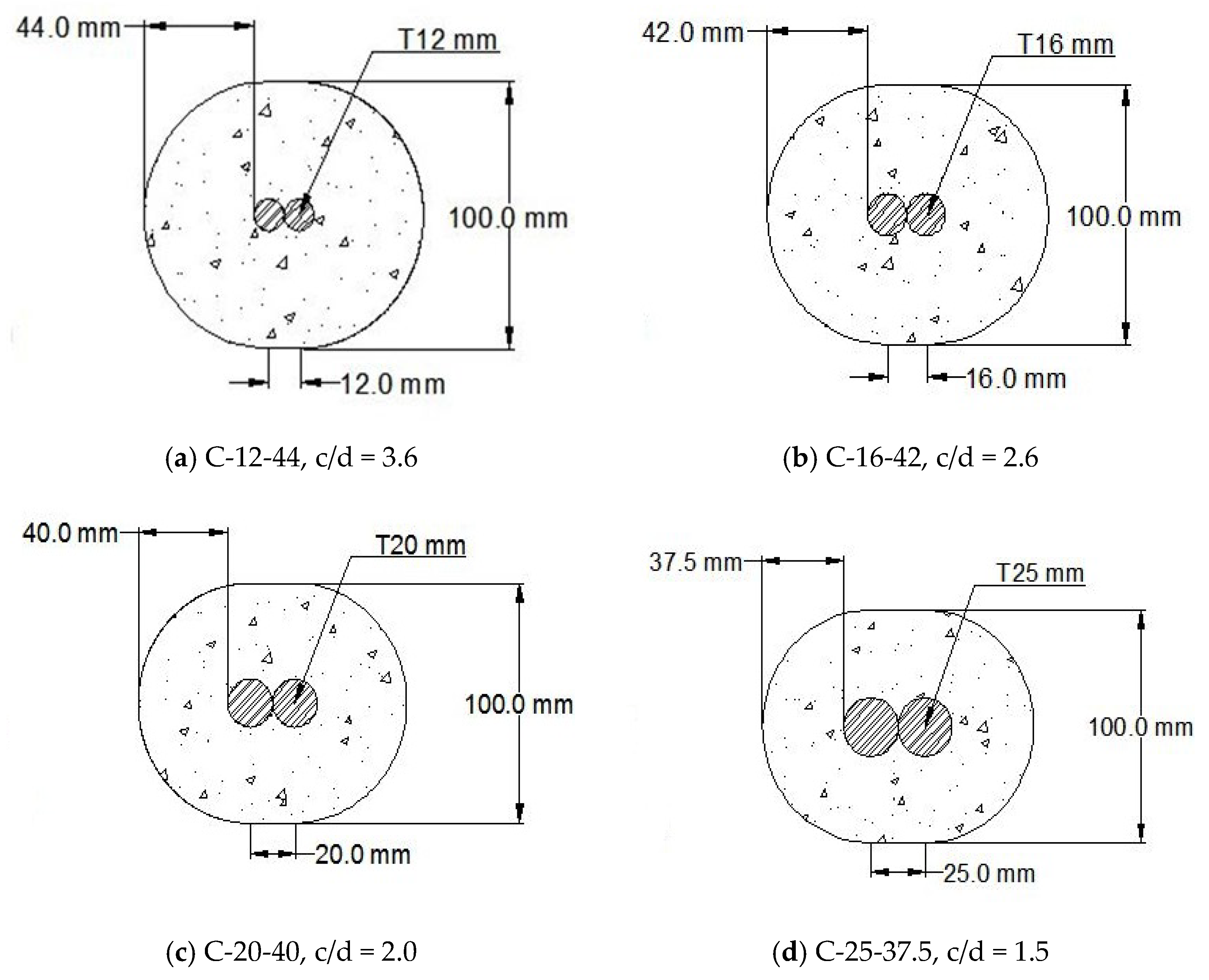
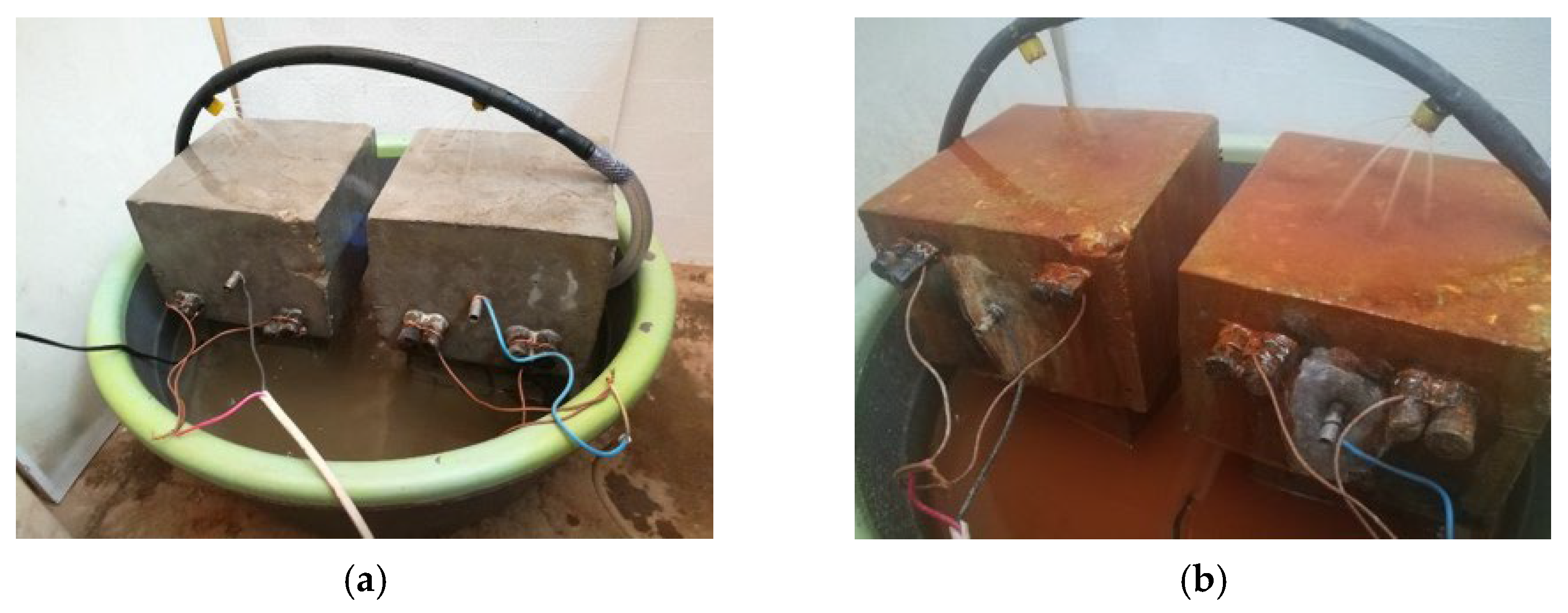

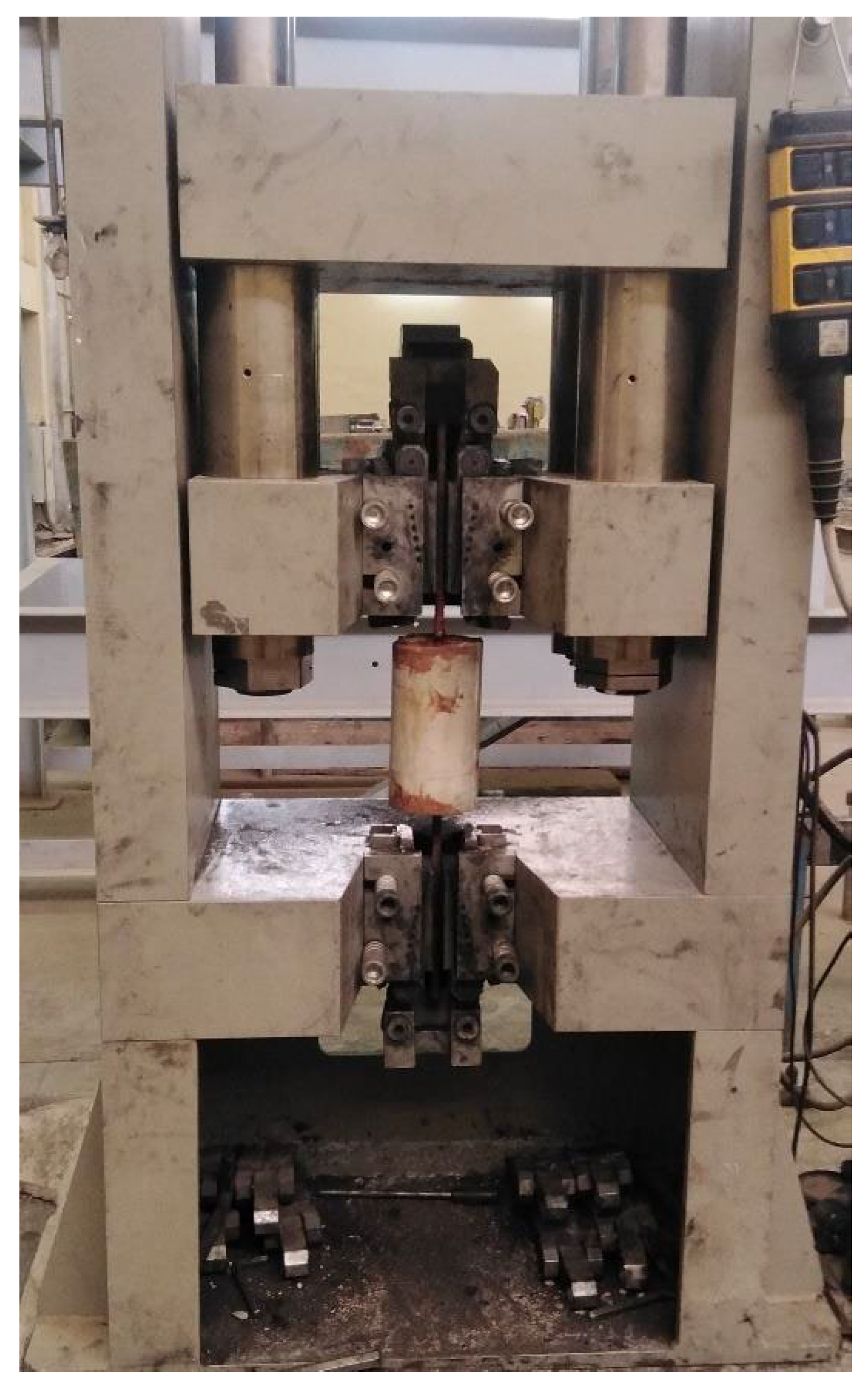
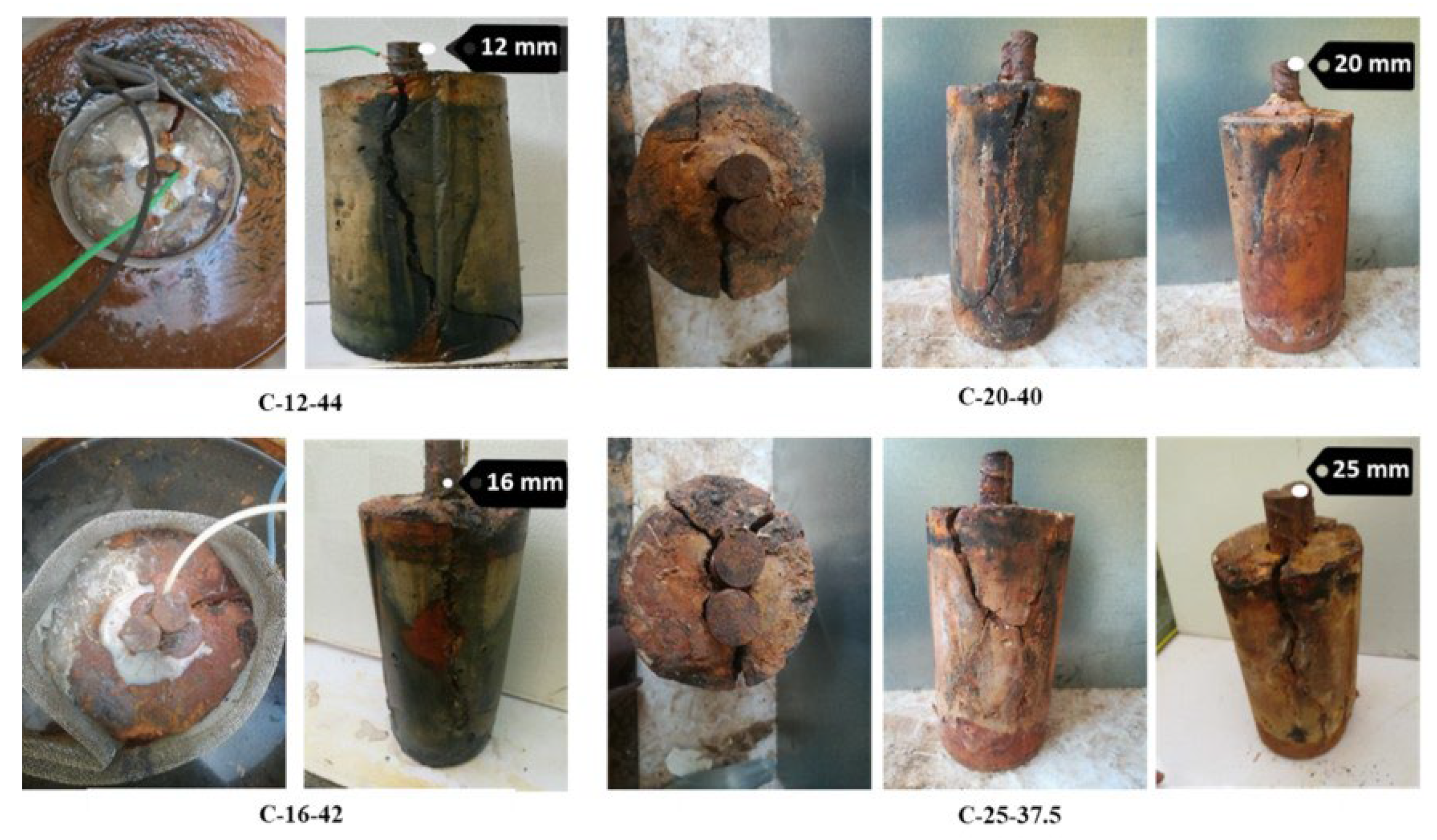
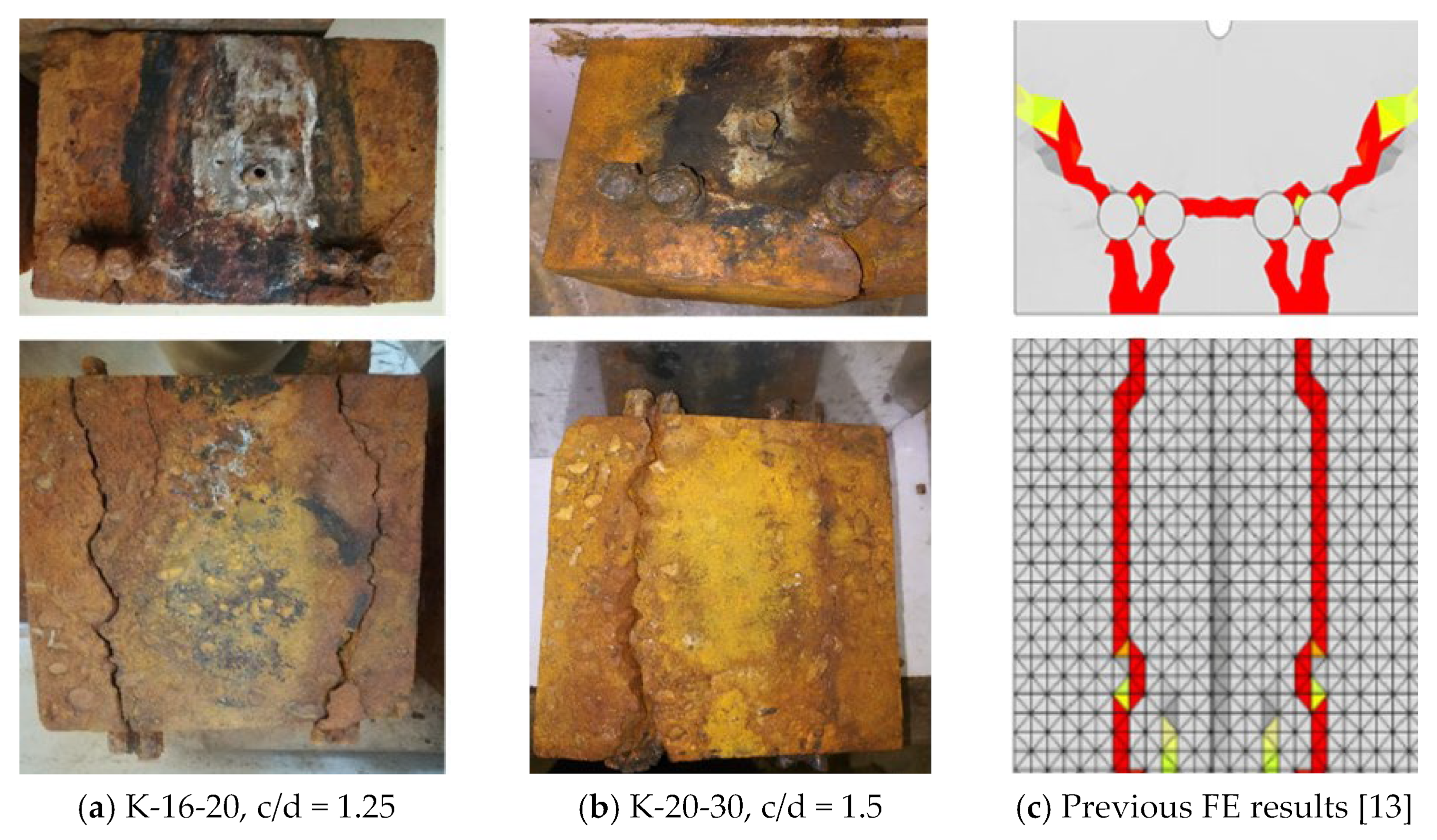







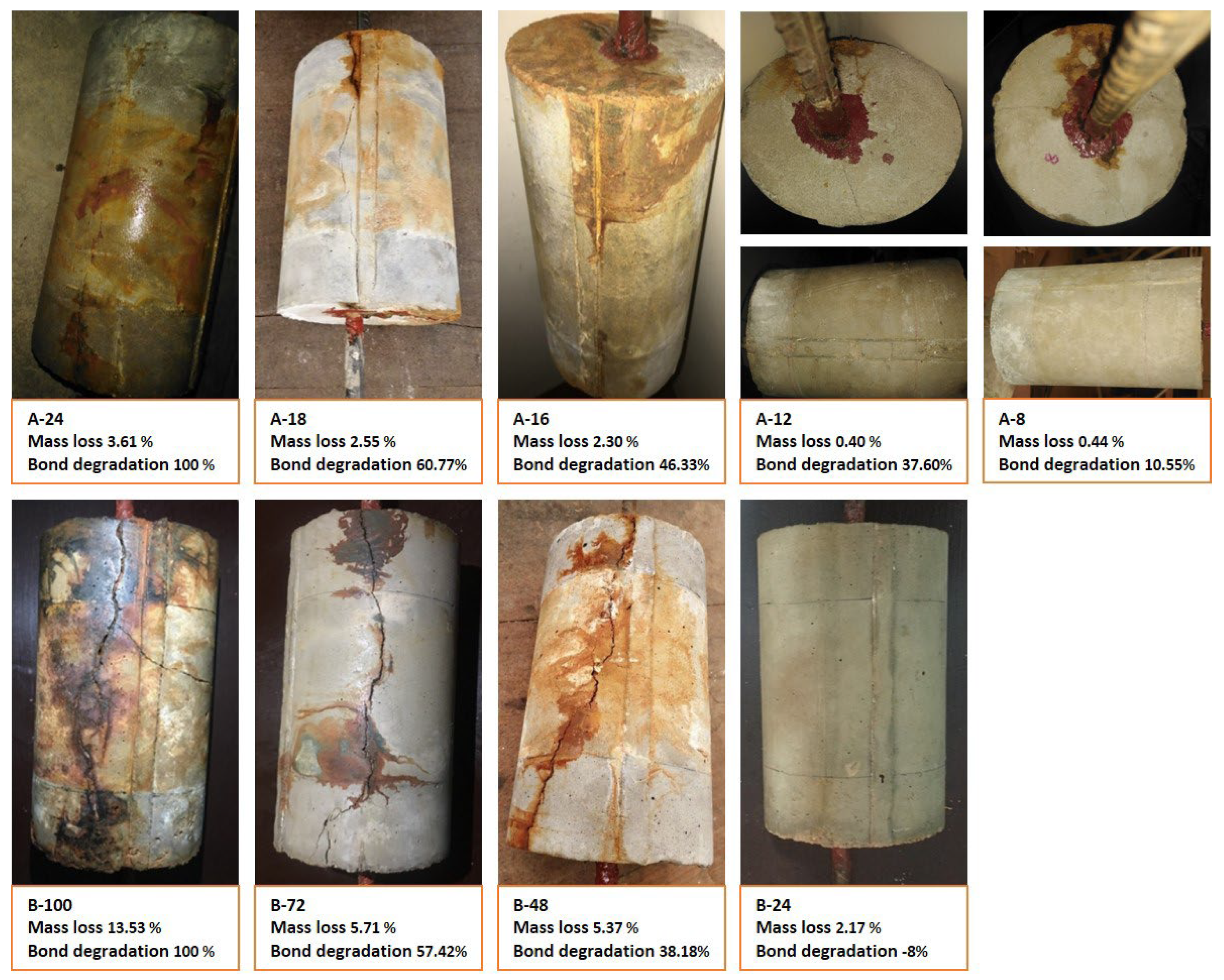
| Test | Sample Type | No. of Samples | Bar Diameter (mm) | Lap Length | Stel Extension | Test After | Test Procedure |
|---|---|---|---|---|---|---|---|
| Crack Pattern | Block | 2 | 16 | Full sample length (200 mm) | No | 28 days | Visual Inspection |
| 25 | |||||||
| Simi-cylinder | 4 | 12 | Full sample length (200 mm | No | 28 days | Visual Inspection | |
| 16 | |||||||
| 20 | |||||||
| 25 | |||||||
| Bond degradation | Simi-cylinder (Type A) | 6 | 12 | 110 mm | Yes | 5 months | Pull-out test |
| Simi-cylinder (Type B) | 5 | 12 | 100 mm | Yes | 28 days | Pull-out test |
| Group | Group A | Group B | |||||||||
|---|---|---|---|---|---|---|---|---|---|---|---|
| Sample ID | A-0 (Control) | A-8 | A-12 | A-16 | A-18 | A-24 | B-0 (Control) | B-24 | B-48 | B-72 | B-100 |
| Test duration (hours) | 0 | 8 | 12 | 16 | 18 | 24 | 0 | 24 | 48 | 72 | 100 |
| Group | Sample ID | Current Density (A/cm2) | Mass Loss (gm) | Mass Loss (%) | Reduction in Bar Diameter (mm) | Diameter Reduction (%) | Section Loss (%) |
|---|---|---|---|---|---|---|---|
| Group A | A-0 (Control) | - | 0 | 0 | 0 | 0.00% | 0.00% |
| A-16 | 0.122 | 4.6 | 2.3 | 0.098809 | 0.82% | 1.64% | |
| A-12 | 0.0285 | 0.81 | 0.4 | 0.017340 | 0.14% | 0.29% | |
| A-8 | 0.047 | 0.87 | 0.44 | 0.018625 | 0.16% | 0.31% | |
| Group B | B-0 (Control) | - | 0 | 0 | 0 | 0.00% | 0.00% |
| B-100 | 0.226 | 27.15 | 13.53 | 0.595566 | 4.96% | 9.68% | |
| B-72 | 0.133 | 11.45 | 5.71 | 0.247488 | 2.06% | 4.08% | |
| B-48 | 0.187 | 10.8 | 5.37 | 0.233299 | 1.94% | 3.85% | |
| B-24 | 0.151 | 4.35 | 2.17 | 0.093418 | 0.78% | 1.55% |
| Group | Sample ID | Bond Strength (N/mm2) | Degradation in Bond Strength (N/mm2) | Degradation in Bond Strength (%) |
|---|---|---|---|---|
| Group A | A-0 (Control) | 4.36 | 0.00 | 0.00 |
| A-16 | 2.34 | 2.02 | 46.33 | |
| A-12 | 2.72 | 1.64 | 37.60 | |
| A-8 | 3.90 | 0.46 | 10.55 | |
| Group B | B-0 (Control) | 3.15 | 0.00 | 0.00 |
| B-100 | 0.00 | 3.15 | 100.00 | |
| B-72 | 1.34 | 1.81 | 57.42 | |
| B-48 | 1.95 | 1.20 | 38.18 | |
| B-24 | 3.40 | −0.25 | −8.00 |
Disclaimer/Publisher’s Note: The statements, opinions and data contained in all publications are solely those of the individual author(s) and contributor(s) and not of MDPI and/or the editor(s). MDPI and/or the editor(s) disclaim responsibility for any injury to people or property resulting from any ideas, methods, instructions or products referred to in the content. |
© 2025 by the authors. Licensee MDPI, Basel, Switzerland. This article is an open access article distributed under the terms and conditions of the Creative Commons Attribution (CC BY) license (https://creativecommons.org/licenses/by/4.0/).
Share and Cite
Abdelatif, A.O.; Onsa, S.E.; Ahmed, A.E.; Abdelraouf, E.A.; Abdalgader, R.M.; Ibrahim, M.I.; Ožbolt, J. Corrosion Effects on Bond Degradation and Cracking Patterns in Lapped Spliced Joints of Reinforced Concrete. Constr. Mater. 2025, 5, 8. https://doi.org/10.3390/constrmater5010008
Abdelatif AO, Onsa SE, Ahmed AE, Abdelraouf EA, Abdalgader RM, Ibrahim MI, Ožbolt J. Corrosion Effects on Bond Degradation and Cracking Patterns in Lapped Spliced Joints of Reinforced Concrete. Construction Materials. 2025; 5(1):8. https://doi.org/10.3390/constrmater5010008
Chicago/Turabian StyleAbdelatif, Amged O., Sara E. Onsa, Aya E. Ahmed, Eiman A. Abdelraouf, Razan M. Abdalgader, Mohamed I. Ibrahim, and Joško Ožbolt. 2025. "Corrosion Effects on Bond Degradation and Cracking Patterns in Lapped Spliced Joints of Reinforced Concrete" Construction Materials 5, no. 1: 8. https://doi.org/10.3390/constrmater5010008
APA StyleAbdelatif, A. O., Onsa, S. E., Ahmed, A. E., Abdelraouf, E. A., Abdalgader, R. M., Ibrahim, M. I., & Ožbolt, J. (2025). Corrosion Effects on Bond Degradation and Cracking Patterns in Lapped Spliced Joints of Reinforced Concrete. Construction Materials, 5(1), 8. https://doi.org/10.3390/constrmater5010008







